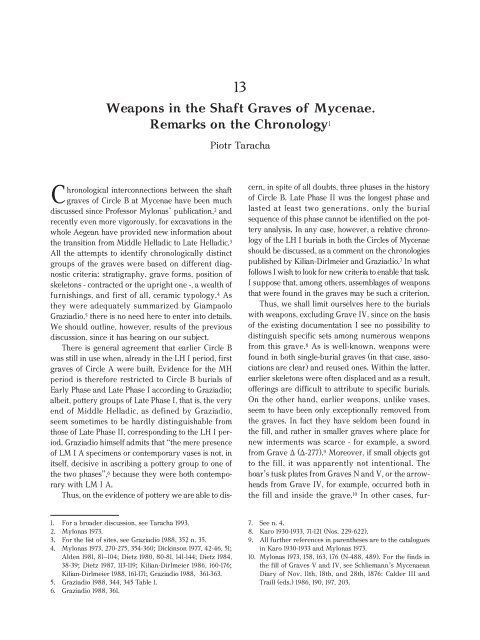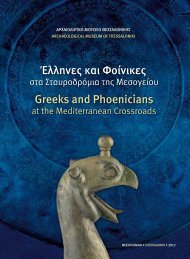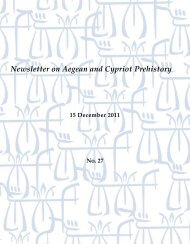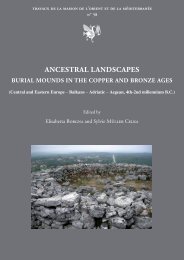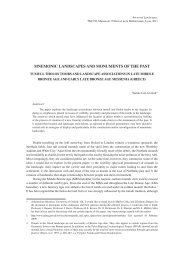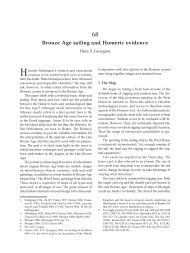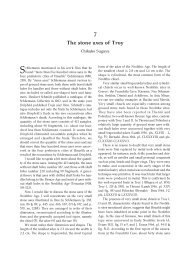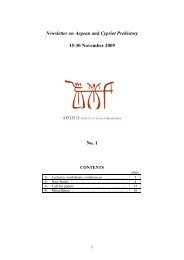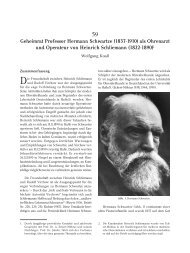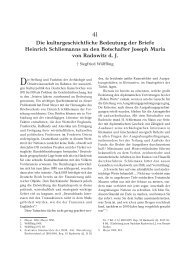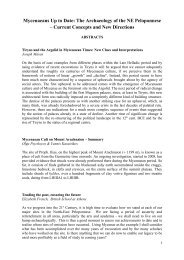13Weapons in the Shaft Graves of Mycenae.Remarks on the Chronology 1Piotr TarachaChronological interconnections between the shaftgraves of Circle B at Mycenae have been muchdiscussed since Professor Mylonas’ publication, 2 <strong>and</strong>recently even more vigorously, for excavations in thewhole Aegean have provided new information aboutthe transition from Middle Helladic to Late Helladic. 3All the attempts to identify chronologically distinctgroups of the graves were based on different diagnosticcriteria: stratigraphy, grave forms, position ofskeletons - contracted or the upright one -, a wealth offurnishings, <strong>and</strong> first of all, ceramic typology. 4 Asthey were adequately summarized by GiampaoloGraziadio, 5 there is no need here to enter into details.We should outline, however, results of the previousdiscussion, since it has bearing on our subject.There is general agreement that earlier Circle Bwas still in use when, already in the LH I period, firstgraves of Circle A were built. Evidence for the MHperiod is therefore restricted to Circle B burials ofEarly Phase <strong>and</strong> Late Phase I according to Graziadio;albeit, pottery groups of Late Phase I, that is, the veryend of Middle Helladic, as defined by Graziadio,seem sometimes to be hardly distinguishable fromthose of Late Phase II, corresponding to the LH I period.Graziadio himself admits that “the mere presenceof LM I A specimens or contemporary vases is not, initself, decisive in ascribing a pottery group to one ofthe two phases”, 6 because they were both contemporarywith LM I A.Thus, on the evidence of pottery we are able to discern,in spite of all doubts, three phases in the historyof Circle B. Late Phase II was the longest phase <strong>and</strong>lasted at least two generations, only the burialsequence of this phase cannot be identified on the potteryanalysis. In any case, however, a relative chronologyof the LH I burials in both the Circles of Mycenaeshould be discussed, as a comment on the chronologiespublished by Kilian-Dirlmeier <strong>and</strong> Graziadio. 7 In whatfollows I wish to look for new criteria to enable that task.I suppose that, among others, assemblages of weaponsthat were found in the graves may be such a criterion.Thus, we shall limit ourselves here to the burialswith weapons, excluding Grave IV, since on the basisof the existing documentation I see no possibility todistinguish specific sets among numerous weaponsfrom this grave. 8 As is well-known, weapons werefound in both single-burial graves (in that case, associationsare clear) <strong>and</strong> reused ones. Within the latter,earlier skeletons were often displaced <strong>and</strong> as a result,offerings are difficult to attribute to specific burials.On the other h<strong>and</strong>, earlier weapons, unlike vases,seem to have been only exceptionally removed fromthe graves. In fact they have seldom been found inthe fill, <strong>and</strong> rather in smaller graves where place fornew interments was scarce - for example, a swordfrom Grave ∆ (∆-277). 9 Moreover, if small objects gotto the fill, it was apparently not intentional. Theboar’s tusk plates from Graves N <strong>and</strong> V, or the arrowheadsfrom Grave IV, for example, occurred both inthe fill <strong>and</strong> inside the grave. 10 In other cases, fur-1. For a broader discussion, see Taracha 1993.2. Mylonas 1973.3. For the list of sites, see Graziadio 1988, 352 n. 35.4. Mylonas 1973, 270-275, 354-360; Dickinson 1977, 42-46, 51;Alden 1981, 81--104; Dietz 1980, 80-81, 141-144; Dietz 1984,38-39; Dietz 1987, 113-119; Kilian-Dirlmeier 1986, 160-176;Kilian-Dirlmeier 1988, 161-171; Graziadio 1988, 361-363.5. Graziadio 1988, 344, 345 Table 1.6. Graziadio 1988, 361.7. See n. 4.8. Karo 1930-1933, 71-121 (Nos. 229-622).9. All further references in parentheses are to the cataloguesin Karo 1930-1933 <strong>and</strong> Mylonas 1973.10. Mylonas 1973, 158, 163, 176 (N-488, 489). For the finds inthe fill of Graves V <strong>and</strong> IV, see <strong>Schliemann</strong>’s MycenaeanDiary of Nov. 11th, 18th, <strong>and</strong> 28th, 1876: Calder III <strong>and</strong>Traill (eds.) 1986, 190, 197, 203.
Weapons in the Shaft Graves of Mycenae. Remarks on the Chronology 119nishings of earlier burials were moved aside whenneeded. Most often, however, they still lay near displacedbodies. Amongst three earlier burials in largeGrave Γ, only interment No. 3, following Mylonas’numbering, had been moved to the northwest corner,whereas two other skeletons (Nos. 2 <strong>and</strong> 4, thelatter with associated weapons) remained wherethey had been originally placed, beside the newinterment No. 1.The Early Phase burials follow the mainl<strong>and</strong> MHtraditions, also in weapons. The one-edged knife fromGrave Θ, the tongue-shaped dagger 11 from Grave H(H-290), <strong>and</strong> the sword from Grave Z (Z-289), allapparently associated with single burials, are notexceptional. Quite large number of similar burials isknown from other MH sites. 12It is also the case of some interments belonging, interms of pottery, to Late Phase I - the tongue-shapeddagger from Grave B (B-261), <strong>and</strong> the sword (I-291)<strong>and</strong> tongue-shaped blade (I-292) assigned to the laterburial in Grave I; although their other goods - an armb<strong>and</strong>(B-354, 355), an electrum shoulder belt (B-356),so-called garters (<strong>Schliemann</strong>’s Gamaschenhalter) (I-378, 379), <strong>and</strong> a silver Vapheio cup (I-327) - already“herald the rise of the Mycenaean civilization”. Infact, the assemblage of weapons found with the earlierinterment in Grave N, also ascribed to this phase,shows new developments. The offerings were heapedtogether with remains of the skeleton along the westwall: a bronze jug (N-310), a golden Vapheio cup (N-389), a diadem (N-391, 392), a pyxis of alabaster (N-458), certainly Cretan import, pieces of a silver vessel(N-329), <strong>and</strong> the weapons - one socketed spearhead(N-308), Karo’s type A sword (N-302), a dagger (N-304), another tongue-shaped blade (N-305, or 306), aone-edged knife (N-307), <strong>and</strong> boar’s tusk plates (N-489) which must have belonged to the same helmet asthe plates from the fill of the grave (N-488). Increasingimpact of Crete is clearly confirmed by theimported alabaster vessel <strong>and</strong> the socketed spearhead,rather unfamiliar in the MH mainl<strong>and</strong>. 13All these furnishings were moved aside, but weshall follow Kilian- Dirlmeier’s assumption that theirinventory appears to be complete, since it can be comparedto the list of goods, including weapons, fromsingle-burial Grave II, dating to the very beginning ofthe LH I period. 14 This grave also contained a goldenVapheio cup (Karo 220), a diadem (Karo 219), importedCretan vases (Karo 221, 223), a bronze vessel (onlyone h<strong>and</strong>le surviving, attached to Karo 215), <strong>and</strong> thesimilar weapons: the socketed spearhead (Karo 215),the type A sword (Karo, 214), the short dagger (Karo217), <strong>and</strong> the tongue-shaped blade (Karo 224c). Theonly difference is the set of four one-edged knives11. The flat, tongue-shaped blades with convex sides aresometimes called razors; cf. Evans 1906, 507; Evans 1928,629-630; Hood 1956, 96-97; Tripathi 1988, 154. Yet, theyhave long been recognized as daggers / knives by others,Blegen 1937, 322 ff., Class b. This latter interpretationseems to be confirmed by the specimen from Aegina, withthe shoulders adorned with golden bull heads; Walter1981, 184 fig. 8 right; Walter 1984, 106 fig. 1d.12. For the MH burials with the single, one-edged knife, see,for example, Voidokoilia, Tumulus A, pithos burials 5 <strong>and</strong>7 (Korres 1978, 354-357; Korres 1979, 144-147, pl. 112γ)Samikon-Kleidhi, cist graves (H. Papakonstantinou apudKorres 1987, 737); Drachmani (Tripathi 1988, 262 No. 236;with further references); Lerna, T. JB-4 (Tripathi 1988, 261No. 232); Asine, MH T. 107 (Tripathi 1988, 262 No. 240);Sesklo, T. 50 (Tripathi 1988, 261 No. 230); Zerelia, T. F (Tripathi1988, 263 No. 246); Giannotion, cist grave (Tripathi1988, 262 No. 235). Burials with the tongue-shaped daggerknife: Eleusis, T. 6 (with boar’s tusk plates; Mylonas1932, 55, 144, 146-148; figs. 119, 121; Tripathi 1988, 258 No.202); Eleusis, T. Z 6 (Tripathi 1988, 265 No. 273); Corinth,T. 5 (Tripathi 1988, 258 No. 203); Sesklo, T. 17 (Tripathi1988, 258 No. 200); Sesklo, T. 25 (together with a oneedgedknife <strong>and</strong> a wavy metal sheet; Tripathi 1988, 258,No. 199; 261 No. 231; 276 No. 505); Αyios Stephanos, T. a28(with bronze tweezers; Tripathi 1988, 351 No. 1186; 355 No.1221); Koukounara-Gouvalari, Grave Circle, T. 1 (Tripathi1988, 351 No. 1188); Kephalovryson Volimidion, T. 1 (togetherwith a one-edged knife <strong>and</strong> 41 stone arrowheads;Tripathi 1988, 258 No. 204; 263 No. 242. Another oneedgedknife from this grave (Tripathi 1988, 263 No. 243)belonged to an earlier displaced burial. Moreover, Varvaregos1981, 88, published a boar’s tusk plate from thisgrave.). The type A sword <strong>and</strong> two knives were foundwith the child-burial in T. Σ5 at Argos, Kaza (Protonotariou-Deilaki1980, 115-119; fig. Σ6; pl. Σ10. 6-7). On the basisof pottery it should be considered contemporary withGrave I of Circle B at Mycenae. Similar assemblages ofweapons, consisting of a sword <strong>and</strong> the one-edged knife,occur at Epano Englianos, tholos Vagenas, Pit I (Tripathi1988, 325 No. 905; 336 No. 1067) <strong>and</strong> at Vajzë, Tumulus I(Hammond’s A), ustrinum (Hammond 1967, 229, 237 f.;fig. 20G, 21A).13. The only two socketed spearheads which are said to dateback to the MH III period, came from Malthi, room C-14(Tripathi 1988, 261 No. 227) <strong>and</strong> from Mycenae, Acropolis,trial pit (Tripathi 1988, 261 No. 226). Yet, the stratificationof Malthi is suspect, <strong>and</strong> the Mycenaean specimen wasfound only in a trial pit.14. Kilian-Dirlmeier 1986, 161, 166.
- Seite 1 und 2:
ΑΡΧΑΙΟΛΟΓΙΑ ΚΑΙ ΕΡ
- Seite 3 und 4:
Περιεχόμενα - Contents -
- Seite 5 und 6:
Περιεχόμενα - Contents -
- Seite 7:
Περιεχόμενα - Contents -
- Seite 10 und 11:
XΠρόλογος - Foreword - Vorw
- Seite 13 und 14:
Κατάλογος συμμετεχ
- Seite 15 und 16:
Κατάλογος συμμετεχ
- Seite 17 und 18:
Χαιρετισμοί - Opening ce
- Seite 19 und 20:
Χαιρετισμοί - Οpening c
- Seite 21 und 22:
Χαιρετισμοί - Οpening c
- Seite 23 und 24:
Χαιρετισμοί - Οpening c
- Seite 25 und 26:
Χαιρετισμοί - Οpening c
- Seite 27 und 28:
Χαιρετισμοί - Οpening c
- Seite 29 und 30:
Χαιρετισμοί - Οpening c
- Seite 31 und 32:
Χαιρετισμοί - Οpening c
- Seite 33 und 34:
Χαιρετισμοί - Οpening c
- Seite 35 und 36:
Χαιρετισμοί - Οpening c
- Seite 37 und 38:
Πρόγραμμα Συνεδρίο
- Seite 39 und 40:
Πρόγραμμα Συνεδρίο
- Seite 41 und 42:
Επιτροπές - Committees - K
- Seite 43 und 44:
Δελτία τύπου - Press rel
- Seite 45 und 46:
Δελτία τύπου - Press rel
- Seite 47 und 48:
Ψήφισμα 21 ης Απριλί
- Seite 49 und 50:
Κατάλογος δημοσιευ
- Seite 51:
Συντομογραφίες - Abbr
- Seite 55 und 56:
1On the beginnings of field archaeo
- Seite 57:
On the beginnings of field archaeol
- Seite 60 und 61:
8 Manfred Korfmannthe epithet “wi
- Seite 62 und 63:
10 Manfred Korfmannfinds and contex
- Seite 64 und 65:
12 Manfred Korfmannsplitting, uncon
- Seite 66 und 67:
14 Manfred Korfmannmight otherwise
- Seite 68 und 69:
16 Donald F. EastonFig. 1. Reconstr
- Seite 70 und 71:
18 Donald F. Eastonmann 1880 no. 14
- Seite 72 und 73:
20 Donald F. EastonFig. 5. Reconstr
- Seite 74 und 75:
22 Donald F. EastonFig. 9. Pottery
- Seite 76 und 77:
24 Donald F. EastonIn terms of rela
- Seite 78 und 79:
26 Donald F. EastonTo the architect
- Seite 80 und 81:
28 Donald F. EastonFig. 18. Reconst
- Seite 82 und 83:
30 Donald F. EastonFig. 20. Chronol
- Seite 84 und 85:
32 Donald F. Easton99-153.Evans, R.
- Seite 86 und 87:
34 Donald F. EastonWeninger, B., 19
- Seite 88 und 89:
36 Edmund Bloedowstatements in this
- Seite 90 und 91:
38 Edmund Bloedowarchaeological sen
- Seite 92 und 93:
40 Edmund Bloedowobjection”, we w
- Seite 94 und 95:
42 Edmund BloedowTo sum up, in view
- Seite 96 und 97:
44 Martin EmeleAlle publizierten Br
- Seite 98 und 99:
46 Martin Emele9. und 8. Jahrundert
- Seite 100 und 101:
48 Martin EmeleNiedergang der myken
- Seite 103 und 104:
Troy and the lower Danube region at
- Seite 105 und 106:
Addendum: Troy VII and the north-ea
- Seite 107:
Addendum: Troy VII and the north-ea
- Seite 111 und 112:
Diaconu, P., 1990. ‘Harpoane de b
- Seite 113 und 114:
6Troas und die Kykladen: Vorbronzez
- Seite 115 und 116:
Troas und die Kykladen: Vorbronzeze
- Seite 117 und 118:
7The stone axes of TroyChikako Suga
- Seite 119 und 120: The stone axes of Troy 67ChiselsAdz
- Seite 121 und 122: The stone axes of Troy 69Tepe, Bes,
- Seite 123 und 124: Schliemann’s Mycenae Albums 71in
- Seite 125 und 126: Schliemann’s Mycenae Albums 73Fig
- Seite 127 und 128: Schliemann’s Mycenae Albums 75Fig
- Seite 129 und 130: Schliemann’s Mycenae Albums 77Fig
- Seite 131 und 132: 9Schliemann’s Mycenae excavations
- Seite 133 und 134: Schliemann’s Mycenae excavations
- Seite 135 und 136: Schliemann’s Mycenae excavations
- Seite 137 und 138: 10Die Schachtgräber von Mykene und
- Seite 139 und 140: Die Schachtgräber von Mykene und d
- Seite 141 und 142: Die Schachtgräber von Mykene und d
- Seite 143 und 144: Die Schachtgräber von Mykene und d
- Seite 145 und 146: 11The altar over shaft grave IV at
- Seite 147 und 148: The altar over shaft grave IV at My
- Seite 149 und 150: The altar over shaft grave IV at My
- Seite 151 und 152: The altar over shaft grave IV at My
- Seite 153 und 154: The altar over shaft grave IV at My
- Seite 155 und 156: The altar over shaft grave IV at My
- Seite 157 und 158: Die Bernsteinschieber von Mykene 10
- Seite 159 und 160: Die Bernsteinschieber von Mykene 10
- Seite 161 und 162: Die Bernsteinschieber von Mykene 10
- Seite 163 und 164: Die Bernsteinschieber von Mykene 11
- Seite 165 und 166: Die Bernsteinschieber von Mykene 11
- Seite 167 und 168: Die Bernsteinschieber von Mykene 11
- Seite 169: Die Bernsteinschieber von Mykene 11
- Seite 173 und 174: Weapons in the Shaft Graves of Myce
- Seite 175 und 176: Weapons in the Shaft Graves of Myce
- Seite 177 und 178: 100 Jahre Ausgrabungen in Tiryns: A
- Seite 179 und 180: 100 Jahre Ausgrabungen in Tiryns: A
- Seite 181 und 182: 100 Jahre Ausgrabungen in Tiryns: A
- Seite 183 und 184: Γεωλογικές παρατηρ
- Seite 185 und 186: Γεωλογικές παρατηρ
- Seite 187 und 188: Γεωλογικές παρατηρ
- Seite 189 und 190: Γεωλογικές παρατηρ
- Seite 191 und 192: A physical and human geographic app
- Seite 193 und 194: A physical and human geographic app
- Seite 195 und 196: H µεσοελλαδική κερα
- Seite 197 und 198: H µεσοελλαδική κερα
- Seite 199 und 200: H µεσοελλαδική κερα
- Seite 201 und 202: H µεσοελλαδική κερα
- Seite 203: H µεσοελλαδική κερα
- Seite 207 und 208: 18Heinrich Schliemann und Ankershag
- Seite 209 und 210: Heinrich Schliemann und Ankershagen
- Seite 211 und 212: Heinrich Schliemann und Ankershagen
- Seite 213 und 214: Heinrich Schliemann und Ankershagen
- Seite 215 und 216: Heinrich Schliemann und Ankershagen
- Seite 217 und 218: Name und Wappen unserer Familie Sch
- Seite 219 und 220: Name und Wappen unserer Familie Sch
- Seite 221 und 222:
Name und Wappen unserer Familie Sch
- Seite 223 und 224:
20Heinrich Schliemanns russische Pe
- Seite 225 und 226:
Heinrich Schliemanns russische Peri
- Seite 227 und 228:
Heinrich Schliemanns russische Peri
- Seite 229 und 230:
Abb. 1. Der Stammbaum der Familie H
- Seite 231:
Heinrich Schliemanns russische Peri
- Seite 235 und 236:
Heinrich Schliemann als Großkaufma
- Seite 237 und 238:
Ἑρρῖκος Σλῆμαν (182
- Seite 239 und 240:
Ἑρρῖκος Σλῆμαν (182
- Seite 241 und 242:
Ἑρρῖκος Σλῆμαν (182
- Seite 243 und 244:
Ἑρρῖκος Σλῆμαν (182
- Seite 245 und 246:
Ἑρρῖκος Σλῆμαν (182
- Seite 247 und 248:
Ἑρρῖκος Σλῆμαν (182
- Seite 249 und 250:
Ἑρρῖκος Σλῆμαν (182
- Seite 251 und 252:
Ἑρρῖκος Σλῆμαν (182
- Seite 253 und 254:
Ἑρρῖκος Σλῆμαν (182
- Seite 255 und 256:
Ἑρρῖκος Σλῆμαν (182
- Seite 257 und 258:
Ἑρρῖκος Σλῆμαν (182
- Seite 259 und 260:
Ἑρρῖκος Σλῆμαν (182
- Seite 261 und 262:
Ἑρρῖκος Σλῆμαν (182
- Seite 263 und 264:
Ἑρρῖκος Σλῆμαν (182
- Seite 265 und 266:
Ἑρρῖκος Σλῆμαν (182
- Seite 267 und 268:
Ἑρρῖκος Σλῆμαν (182
- Seite 269 und 270:
Ἑρρῖκος Σλῆμαν (182
- Seite 271 und 272:
Ἑρρῖκος Σλῆμαν (182
- Seite 273 und 274:
Ἑρρῖκος Σλῆμαν (182
- Seite 275 und 276:
Ἑρρῖκος Σλῆμαν (182
- Seite 277 und 278:
Ἑρρῖκος Σλῆμαν (182
- Seite 279 und 280:
23Wiederentdecktes Griechenland. So
- Seite 281 und 282:
Wiederentdecktes Griechenland. Soph
- Seite 283 und 284:
Wiederentdecktes Griechenland. Soph
- Seite 285 und 286:
Wiederentdecktes Griechenland. Soph
- Seite 287 und 288:
Heinrich Schliemann, the linguist 2
- Seite 289 und 290:
Heinrich Schliemann, the linguist 2
- Seite 291 und 292:
Schliemanns archäologische Lebensl
- Seite 293 und 294:
Schliemanns archäologische Lebensl
- Seite 295 und 296:
Schliemanns archäologische Lebensl
- Seite 297 und 298:
Schliemann als Zeitgenosse 245seine
- Seite 299 und 300:
Schliemann als Zeitgenosse 247Schli
- Seite 301 und 302:
Schliemanns Beziehungen zu Berlin 2
- Seite 303 und 304:
Schliemanns Beziehungen zu Berlin 2
- Seite 305 und 306:
Schliemanns Beziehungen zu Berlin 2
- Seite 307 und 308:
28Die Verbundenheit Fürstenbergs z
- Seite 309:
III.H αλληλογραφία το
- Seite 312 und 313:
260 Galina Andrusovova′-Vlcekova
- Seite 314 und 315:
262 Wilfried Bölke und Reinhard Wi
- Seite 316 und 317:
31Heinrich Schliemann und die preu
- Seite 318 und 319:
266 Barbara Faensendeutsche Levante
- Seite 320 und 321:
268 Alexander K. GavrilovKommission
- Seite 322 und 323:
270 Alexander K. GavrilovÖffentlic
- Seite 324 und 325:
272 Alexander K. Gavrilovthe milk f
- Seite 326 und 327:
33Entwicklung von Forschungsmethode
- Seite 328 und 329:
276 Joachim Herrmannphische Methode
- Seite 330 und 331:
278 Joachim HerrmannLetzten Endes k
- Seite 332 und 333:
280 Johannes IrmscherJugendfreund W
- Seite 334 und 335:
282 Johannes Irmschermanns Unterneh
- Seite 336 und 337:
284 Johannes IrmscherMeter hoch und
- Seite 338 und 339:
286 Hans-Günter Buchholznoch im se
- Seite 340 und 341:
288 Hans-Günter BuchholzFunden die
- Seite 342 und 343:
290 Hans-Günter BuchholzProf. Geor
- Seite 344 und 345:
292 Hans-Günter Buchholzgie folgte
- Seite 346 und 347:
294 Hans-Günter Buchholzfahl eine
- Seite 348 und 349:
296 Hans-Günter Buchholznicht ganz
- Seite 350 und 351:
298 Hans-Günter BuchholzBewegung s
- Seite 352 und 353:
300 Hans-Günter BuchholzIch schlie
- Seite 354 und 355:
302 Hans-Günter Buchholzwenn Milch
- Seite 356 und 357:
304 Hans-Günter Buchholzhält, ist
- Seite 358 und 359:
306 Hans-Günter Buchholzchen und R
- Seite 360 und 361:
308 Hans-Günter BuchholzSchulze, E
- Seite 362 und 363:
310 Hans-Günter BuchholzAbb. 2. Br
- Seite 364:
312 Hans-Günter BuchholzAbb. 3b. B
- Seite 372 und 373:
320 Claudia Lang-Auingerersten Ber
- Seite 374 und 375:
322 Claudia Lang-Auingerberichtet a
- Seite 376 und 377:
324 \Aνδρέας Παναγόπο
- Seite 378 und 379:
326 \Aνδρέας Παναγόπο
- Seite 380 und 381:
39Wilhelm Dörpfeld: Schliemann’s
- Seite 382 und 383:
330 Kenneth W. Schaarancient buildi
- Seite 384 und 385:
332 Kenneth W. Schaarning of a care
- Seite 386 und 387:
334 Gerlinde GrahnMuseums zur Verf
- Seite 388 und 389:
336 Gerlinde Grahnganze Baustelle a
- Seite 390 und 391:
338 Gerlinde Grahntürkischen Staat
- Seite 392 und 393:
340 Gerlinde GrahnBericht der Gesan
- Seite 394 und 395:
342 Gerlinde Grahnschaften in Konst
- Seite 396 und 397:
344 Gerlinde Grahngeplanten Neubau
- Seite 398 und 399:
346 Gerlinde Grahntivem Bescheid zu
- Seite 400 und 401:
41Die kulturgeschichtliche Bedeutun
- Seite 402 und 403:
350 Siegfried WölfflingDörpfeld i
- Seite 404 und 405:
352 Siegfried Wölfflingaber als Fr
- Seite 407:
IV.Φιλολογικές παρα
- Seite 410 und 411:
358 Egert PöhlmannToday, we again
- Seite 412 und 413:
360 Egert Pöhlmannare standing ins
- Seite 414 und 415:
362 Egert PöhlmannBes,ik Bay, dire
- Seite 416 und 417:
364 Egert PöhlmannLatacz, J., 1979
- Seite 418 und 419:
366 Mark Lehrermann embarked on his
- Seite 420 und 421:
368 Mark Lehrerbe probed -, but in
- Seite 422 und 423:
370 Mark Lehrerast. There is, to be
- Seite 424 und 425:
372 Brigitte MannspergerAbb. 1. Pha
- Seite 426 und 427:
374 Brigitte Mannspergerden und der
- Seite 428 und 429:
376 Brigitte Mannspergerkampf Menel
- Seite 430 und 431:
378 Brigitte MannspergerMannsperger
- Seite 432 und 433:
380 David Turnerhere; only letters
- Seite 434 und 435:
382 David Turnerever. His attention
- Seite 436 und 437:
46Schliemann und die Schriftlichkei
- Seite 438 und 439:
386 Imre TegyeryEs war eigentlich e
- Seite 440 und 441:
388 Imre Tegyeryund Alphabet, Sylla
- Seite 443 und 444:
47Schliemann’s contribution to Gr
- Seite 445 und 446:
Schliemann’s contribution to Gree
- Seite 447 und 448:
Schliemann’s contribution to Gree
- Seite 449 und 450:
Schliemann’s contribution to Gree
- Seite 451 und 452:
Schliemann’s contribution to Gree
- Seite 453 und 454:
48^H àξιοπιστία τοÜ Σ
- Seite 455 und 456:
^H àξιοπιστία τοÜ Σλ
- Seite 457 und 458:
Beobachtungen zur Chronologie und S
- Seite 459 und 460:
Beobachtungen zur Chronologie und S
- Seite 461 und 462:
Beobachtungen zur Chronologie und S
- Seite 463:
VI.H Tρωική συλλογή κ
- Seite 466 und 467:
414 Manfred OppermannZunächst seie
- Seite 468 und 469:
51Der Schatten des geraubten Goldes
- Seite 470 und 471:
418 Leo S. KlejnLyshina verheiratet
- Seite 472 und 473:
420 Leo S. Klejnfend, daß er sie a
- Seite 474 und 475:
422 J. Lesley Fittonparagraph of a
- Seite 476 und 477:
424 J. Lesley Fittonsified account
- Seite 478 und 479:
426 Marion Bertram, Ingrid Griesa u
- Seite 480 und 481:
428 Marion Bertram, Ingrid Griesa u
- Seite 482 und 483:
430 Marion Bertram, Ingrid Griesa u
- Seite 484 und 485:
432 Wolfgang KuckenburgSchmucksache
- Seite 486 und 487:
434 Wolfgang KuckenburgAbbildung 1
- Seite 488 und 489:
436 Wolfgang Kuckenburggenannten ,,
- Seite 490 und 491:
438 Wolfgang KuckenburgWerkstatt, u
- Seite 493 und 494:
55Deutsche Pompeiana vom Wörlitzer
- Seite 495 und 496:
Deutsche Pompeiana vom Wörlitzer L
- Seite 497 und 498:
Deutsche Pompeiana vom Wörlitzer L
- Seite 499 und 500:
Deutsche Pompeiana vom Wörlitzer L
- Seite 501 und 502:
56Ιλίου Μέλαθρον. Η
- Seite 503 und 504:
Ιλίου Μέλαθρον. Η ο
- Seite 505 und 506:
Ιλίου Μέλαθρον. Η ο
- Seite 507 und 508:
Ιλίου Μέλαθρον. Η ο
- Seite 509 und 510:
Ιλίου Μέλαθρον. Η ο
- Seite 511 und 512:
Ιλίου Μέλαθρον. Η ο
- Seite 513 und 514:
Ιλίου Μέλαθρον. Η ο
- Seite 515 und 516:
Ιλίου Μέλαθρον. Η ο
- Seite 517 und 518:
57Das Schliemann-Haus im Spiegel gr
- Seite 519:
Das Schliemann-Haus im Spiegel grie
- Seite 523 und 524:
58Wie wirkte sich der zeitgenössis
- Seite 525 und 526:
Wie wirkte sich der zeitgenössisch
- Seite 527 und 528:
Wie wirkte sich der zeitgenössisch
- Seite 529 und 530:
Geheimrat Professor Hermann Schwart
- Seite 531 und 532:
Geheimrat Professor Hermann Schwart
- Seite 533 und 534:
The operation and death of Henry Sc
- Seite 535 und 536:
The operation and death of Henry Sc
- Seite 537 und 538:
Il funerale di Heinrich Schliemann
- Seite 539 und 540:
62Το ωτολογικό πρόβ
- Seite 541 und 542:
Tο ωτολογικό πρόβλη
- Seite 543 und 544:
Tο ωτολογικό πρόβλη
- Seite 545 und 546:
Ἡ ἐκτέλεσις τῆς δ
- Seite 547 und 548:
Ἡ ἐκτέλεσις τῆς δ
- Seite 549 und 550:
Ἡ ἐκτέλεσις τῆς δ
- Seite 551:
Ἡ ἐκτέλεσις τῆς δ
- Seite 555 und 556:
64Schliemann und HalleHans-Dieter Z
- Seite 557 und 558:
Schliemann und Halle 505Abb. 2. Die
- Seite 559 und 560:
Schliemann und Halle 507beherrschun
- Seite 561 und 562:
65Die ,,Heinrich-Schliemann-Gesells
- Seite 563 und 564:
Die ,,Heinrich-Schliemann-Gesellsch
- Seite 565 und 566:
Die ,,Heinrich-Schliemann-Gesellsch
- Seite 567 und 568:
Die ,,Heinrich-Schliemann-Gesellsch
- Seite 569 und 570:
Kein Museum für Schliemann. Eine B
- Seite 571 und 572:
67Ο Γεώργιος Καστρι
- Seite 573 und 574:
O Γεώργιος Kαστριώτ
- Seite 575 und 576:
68Bronze Age sailing and Homeric ev
- Seite 577 und 578:
Bronze Age sailing and Homeric evid
- Seite 579 und 580:
Bronze Age sailing and Homeric evid
- Seite 581:
Bronze Age sailing and Homeric evid


